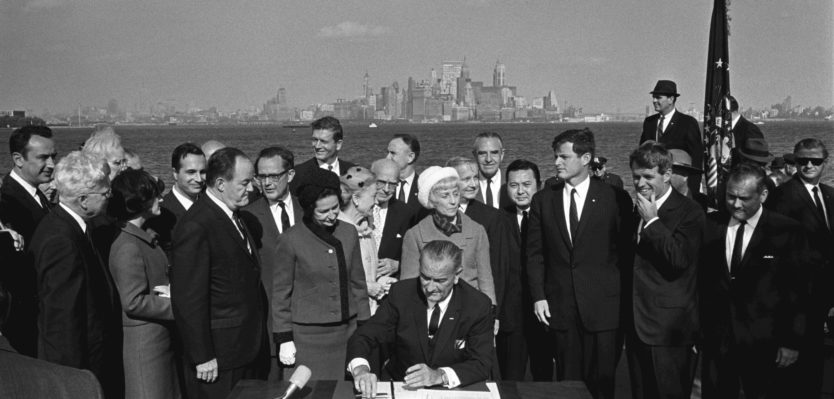The Immigration and Nationality Act of 1965 – signed into law on October 3th, 1965 and effective on June 30th, 1968 – was a watershed piece of immigration legislation that has had tremendous impact on the country and especially the South Asian American community. The Act made immigration more inclusive and emphasized family unification, setting up the means by which South Asians (and many others who were systematically excluded) could immigrate to the U.S. The 50 year anniversary mark of the enactment of the law, however, juxtaposes both the result of these inclusive values and policies and the explicit attempts by the current administration to undermine these values and to return to more restrictive and discriminatory immigration systems.
Prior to the 1965 law, immigration was based on national origin quotas which discriminated against Asian and African immigrants. The National Origins Quota Act of 1924 capped immigration to 150,000 immigrants per year and set annual quotas based on the current national origin population proportions in the U.S., which favored immigration from Western and Northern Europe. The Luce-Celler Act of 1946 included setting the quota for Indian immigrants to 100 per year. Similarly, the Immigration and Nationality Act of 1952 set immigrant quotas to 100 for Asian countries more broadly.
The 1965 law dramatically expanded immigration limits and replaced the national origin quota system with one that focused on a preference system that prioritized family unification. The new law allowed for 170,000 annual immigrants from the Eastern Hemisphere with no more than 20,000 immigrants from each country, dramatically increasing opportunities for immigration from Asian countries. The preference system established by the law prioritized issuing visas to family members of U.S. citizens and permanent residents, with 1) unmarried adult children of U.S. citizens and 2) spouses and unmarried children of permanent residents being the two highest priority categories. Other family preference categories included 3) married children over 21 years of age and their spouses and children of U.S. citizens, and 4) siblings and their spouses and children of U.S. citizens. Furthermore, the law recognized the importance of keeping immediate relatives (defined as spouse, unmarried minor children, and parents of a U.S. citizen) together. Visas issued to immediate relatives were not subject to any caps.
The core policies of expanding visas and family unification from the Immigration and Nationality Act of 1965 have remained and served as the basis for the boost in South Asian immigration to the U.S.
As of 2015, there are 4,398,268 South Asians living in the U.S., with 69% being foreign-born immigrants (Census, American Community Survey, 2015). This is compared to the population, for example, of 12,000 Indian immigrants in the U.S. in 1960 (Migration Policy Institute, “Indian Immigrants in the United States,” 2017).
The immediate relative and family preference categories have been especially important. For example, they accounted for 92% of the 65,193 immigrant visas issued to South Asians in Fiscal Year 2015, with siblings (32.12%), parents (22.41%), and spouses of U.S. citizens being the three most prevalent visa categories (U.S. Department of State, “Report of the Visa Office 2015”).
The more inclusive 1965 law and the role of family reunification has been crucial as a pathway for South Asians to immigrate to the U.S. As we reflect on the impact of this legislation 50 years later, we are faced with the concern that the very principles of this law are under attack. The Trump administration, by permitting the separation of immigrant families at the border and the reinstatement of a Muslim ban, has shown repeatedly that its aim is to undermine these values. We must continue to fight for a more inclusive vision for America that recognizes the value of immigrants and for our families’ right to belong, contribute, and thrive in the U.S.

